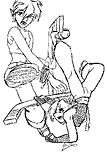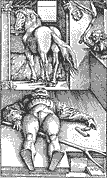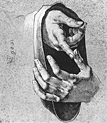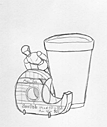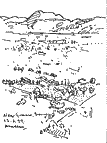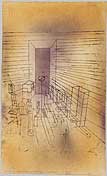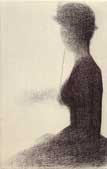Introduction
In the first lecture for this unit there was an introduction to the topic of point-of-view. We began with a brief exercise where you were asked to observe and describe your own viewing space. If one holds one’s head still and surveys, by moving one’s eyes around the periphery of ones vision then one could say that the field of vision covers a field of almost 180 degrees. However, if one fixes one’s viewpoint straight ahead one becomes less aware of detail in the extremities. Effectively we have a cone of vision extending out from our central axis of vision where we have high visual acuity, in other words, where things appear clearest. It is quite narrow close to us and widens farther into the distance. Our vision is also binocular (we have a pair of eyes) and this enables us to judge distance. Our visual perceptual apparatus performs an amazing juggling operation when it merges the information from each of our eyes into seemingly contiguous sight. Try holding one finger up about 20 cm in front of you and closing one eye at a time. What happens to the position of your finger in relation to any features more distant in your vision as you switch from eye to eye?
When one draws from what one sees one necessarily translates the binocular images of three-dimensional visual perception into a two-dimensional arrangement of lines, shapes and tones that are fixed and static (even if multiple viewpoints are included in one composition). This is why Betty Edwards recommends closing one eye when viewing for drawing, especially when observing things that are closer to you. The monocular view is already dimensionally flattened and more stable. The result is what she calls one of the “paradoxes of drawing.”
The flat, two-dimensional image you see (with one eye closed) on the picture-plane, when copied onto your drawing paper, miraculously “looks” three-dimensional to the person who views your drawing.
(Edwards 2012, p100)
Framing and the picture plane
Framing a view for drawing usually involves selecting a portion from the cone of vision. One can try to work with a wider view, akin say to a fish eye lens, but this involves such complexity and shifts in view using both eyes that it is rare. Normally one selects a view that, naturally enough, corresponds to what on a camera we would call a ‘standard' lens. And one composes by imagining a picture plane that slices through the cone of vision at right angles to the axis of view. The surface on which one draws corresponds to this picture plane.
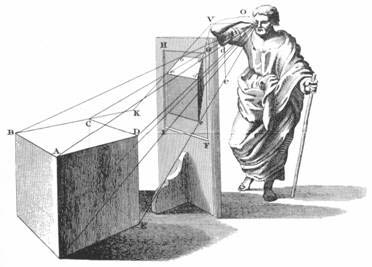
The cone of vision and its relation to the picture plane or drawing surface
(source: http://www.math.nus.edu.sg/aslaksen/projects/perspective/)
Drawing from reality involves translating the spatiality of the world we perceive onto that drawing surface. Two main aspects are defined and controlled by various means in the process of this translation. These are depth and viewpoint. This week we will concentrate on some aspects of our daily visual experience that we may actually take for granted.
Depth Cues
When defining depth it is common to refer to factors that influence interpretation of it in a picture as depth cues, or depth clues. Some depth cues occur as a matter of course during composition and some require more interpretation and decision by the draughtsperson as to whether or not to include them, and if so, how? (by using which graphic technique?). Depth clues correspond to natural phenomena that we encounter all of the time but often we are hardly aware of their part in visual perception:
- foreshortening
- overlapping
- diminishing size
- vertical location
- convergence
- atmospherics (also called aerial perspective)
- texture
Foreshortening
This is the term used to describe the compressed or extended appearance of irregularly shaped objects depending on their orientation in relation to the observer. For example the proportion of a book when viewing its face differs from its proportion when rotated to view its spine and each degree of rotation in-between will yield a different shape.
Overlapping
When an object is partially concealed by something else that object is interpreted as being behind and so an illusion of depth results.
Diminishing size
Similar sized objects will appear smaller when further distant from the viewer. However, interestingly, we can still perceive objects as of a similar category or alike even though they may be appear quite different in size due to depth. We can also make accurate judgments about the actual relative size of similar categories of things despite the seemingly conflicting evidence due to size apparently diminishing in greater depth.
Vertical location
The ground plane is a real or imaginary horizontal plane of reference that usually corresponds to the ground on which the viewer stands, but it could also be an intermediary surface such as a table top or a remote surface such as the sea as seen from a distant hilltop vantage. Generally speaking objects that appear relatively higher vertical location in reference to the ground plane are interpreted as being more distant. This sense of depth is usually congruous with diminishing size and when it is not, especially regarding like objects, ambiguity or confusion results.
Convergence
We know that railway tracks have to be parallel for trains to travel along them but, of course, as the rails disappear into the distance they appear to converge. This is the principle on which linear perspective is based.
Atmospherics, or aerial perspective
The density and the quality of the air alter the appearance of distant things. These effects include variations in clarity and edge definition, changes in hue, tonality and contrast. Details such as textures become less distinct and areas can tend to flatten into zones. Heat causes apparent waviness and mirages. Reflections on expanses of water are another form of atmospherics. Sometimes ships in the distance can appear to be sitting above the water.
Textural changes
The combination of diminishing size and convergence has a compound effect on textured surfaces that recede into the distance. Most notably the textures of brick walls and tiled or paved areas become gradually denser. Foreground textures are distinct and discrete, mid and background textures lesser and lesser so. Atmospherics and changes in lighting conditions play a part here too.
Zones of depth
When analysing a scene or a picture of a scene it can be useful to consider zones of depth. That area closest is the foreground, things well behind are said to be in the background, and in-between is the mid-ground.
Summary and conclusion
William Bardell in his paper, Depth Cues for Information Design, reiterates the points made above from the context of an information designer. He divides depth cues into three main categories according to function. Perspective, the main subject of next week's lecture, he says is to do with structure and order and the understanding of spaces. Occlusion, which includes foreshortening, overlapping, hierachy and separation, is to do with the functions of layering and making connections. Depth cues to do with focus and clarity of detail are related to the function of prioritisation.
References
Bardell, W., (2003) Depth Cues for Information Design, Masters thesis, School of Design, Carnagie Mellon University
Ching, F. D. K., (1990) Drawing - a creative process, John Wiley & Sons, Inc
Edwards, B., (2013) Drawing on the Right Hand Side of the Brain, Souvenir Press


